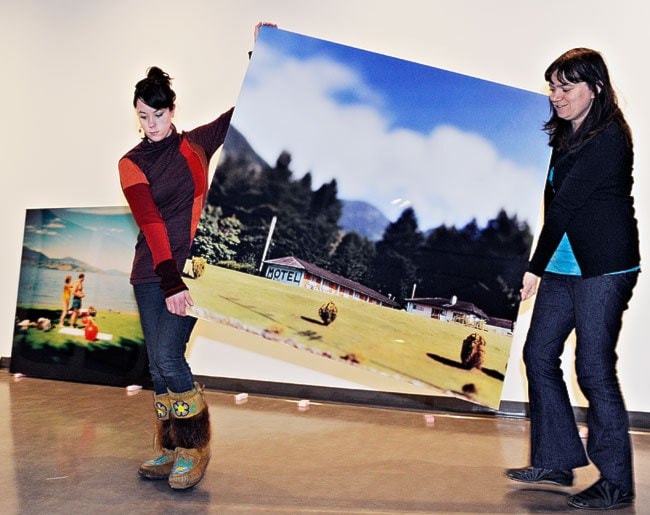It won’t come as a shock to most Yukoners to learn that the North is more than just valiant Mounties, beautiful vistas and colourful characters.
But it’s not just tourists who are lured by the spell of the Yukon.
It’s comforting to see the territory as a land of splendour and beauty, without focusing on some of the environmental threats.
It’s exciting to think of the Yukon as a land of adventure, without focusing on social problems.
This dichotomy between the fictional myth and the uncomfortable truth is the topic of Untrue North, a new group exhibition at the Yukon Arts Centre.
The show attempts to subvert the usual landscape paintings and photos that everyone has come to expect from northern art.
The challenge for visiting curator Earl Miller was those stereotypes were all he had to go on.
Before curating this exhibit, Miller had never been farther north than the West Edmonton Mall.
Then again, when dealing with misconceptions, maybe this was an advantage.
“I felt I was going into territory where I didn’t entirely know what I was talking about so I thought I had to integrate that into my approach,” he said in an interview Tuesday.
“The idea was basically that I wanted to deal with misconceptions of the North because that’s all that I’d been given. I was also interested in how northern artists are reacting to these misconceptions of the North.”
One of the most interesting pieces in the show is work from the Yukon Archives by Martha Louise Black.
Black exemplifies the Yukon myth, having crossed the Chilkoot Pass in 1899 and earned her living by staking gold claims and running a sawmill and gold ore-crushing plant.
In 1904 she married Dawson City lawyer George Black. He went to become the Yukon’s MP. In 1935 Martha Black was the second woman ever elected to Canada’s House of Commons.
Black fastidiously documented the Klondike gold rush, creating a series of hand-tinted glass slides. In many ways, the slides are evidence of the creation of the Yukon myth.
They were used in “magic lantern shows,” a precursor to slide projectors and film.
During the First World War, Black lugged the magic lantern and heavy, coloured glass slides all over England by train, giving 400 lectures about the Yukon.
The images have an unreal quality to them, the colour having been painted on top of the photo. Water appears too blue, trees appear too green.
Other local artists include Joseph Tisiga and Marten Berkman.
Tisiga has a few pieces from his Indian Brand Corporation series, which involves kitsch images of peace pipes and toy Indians superimposed on upside down landscapes photos.
Berkman’s work - anaglyph stereo 3D prints of stone, human and animal forms set against the northern landscape - also plays with the idea of an artificial or virtual North.
While not created by Yukon artists, other works were created in the territory.
A video will be on display of Keven Schmidt’s attempts to outdo the aurora borealis while doing a residency at the Ted Harrison Artist Retreat.
Schmidt set up the type of light show more likely found at a Pink Floyd concert than out in the middle of a frozen Crag Lake. He also set up speakers, pumping out the soundtrack from Close Encounters of the Third Kind.
The exhibit also contains work by Vikky Alexander, Toni Hafkenscheid, Brian Jungen, Mark Lewis and Jin-Me Yoon.
There is often truth behind any myth, said Miller.
He also admitted he had a much different version of what Whitehorse would be like.
“People seem to have a tremendous interest in, maybe not contemporary art, but art and culture and local pride,” he said. “Now coming from Toronto, the average person is interested in art and is insecure about where they live.”
Miller is the third visiting curator the Yukon Arts Centre has hosted.
Many outside curators want to address northern issues in their shows, said gallery director Mary Bradshaw. Usually, it’s something the gallery tries to avoid.
But it seemed appropriate to revisit these issues as the show will still be on during the Arctic Winter Games in early March.
“If the North were not an ideal land, it would mean there is no escape from the south,” said Miller in his artistic statement.
“If Canada loses this ideal alter-ego, it would not only lose part of its identity but also its collective hope for a better land.
“That is, perhaps, too high a price to pay for facing the truth.”
The show opens with a reception on Thursday at 5:30 p.m. It runs until March 10.
Contact Chris Oke at
chriso@yukon-news.com
